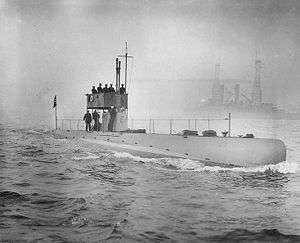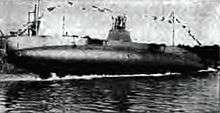USS D-3 (SS-19)
 USS D-3 underway off New York City during the October 1912 Naval Review. Kearsarge is in the background. | |
| History | |
|---|---|
| Name: | USS D-3 |
| Builder: | Fore River Shipbuilding, Quincy, Massachusetts |
| Launched: | 12 March 1910 |
| Commissioned: | 8 September 1910, as USS Salmon |
| Decommissioned: | 20 March 1922 |
| Renamed: | USS D-3, 17 November 1911 |
| Fate: | Sold for scrap, 31 July 1922 |
| General characteristics | |
| Class and type: | D-class submarine |
| Displacement: |
|
| Length: | 134 ft 10 in (41.10 m) |
| Beam: | 13 ft 11 in (4.24 m) |
| Draft: | 12 ft 6 in (3.81 m) |
| Installed power: |
|
| Propulsion: |
|
| Speed: |
|
| Range: |
|
| Test depth: | 200 feet (61.0 m) |
| Complement: | 15 officers and enlisted |
| Armament: | 4 × 18 in (457 mm) bow torpedo tubes |
USS D-3 (SS-19) was a D-class submarine built for the United States Navy in the first decade of the 20th century. It was the first submarine to make an over ocean voyage under its own power.
Description
The D-class submarines were enlarged versions of the preceding C class, the first American submarines armed with four torpedo tubes. They had a length of 134 feet 10 inches (41.1 m) overall, a beam of 13 feet 10 inches (4.2 m) and a mean draft of 12 feet 6 inches (3.8 m). They displaced 288 long tons (293 t) on the surface and 337 long tons (342 t) submerged. The D-class boats had a crew of 1 officer and 14 enlisted men. They had a diving depth of 200 feet (61.0 m).[1]
For surface running, they were powered by two 300-brake-horsepower (224 kW) gasoline engines, each driving one propeller shaft. When submerged each propeller was driven by a 165-horsepower (123 kW) electric motor. They could reach 13 knots (24 km/h; 15 mph) on the surface and 9.5 knots (17.6 km/h; 10.9 mph) underwater. On the surface, the boats had a range of 1,179 nautical miles (2,184 km; 1,357 mi) at 9.6 knots (17.8 km/h; 11.0 mph) and 24 nmi (44 km; 28 mi) at 8 knots (15 km/h; 9.2 mph) submerged.[1]
The boats were armed with four 18-inch (45.7 cm) torpedo tubes in the bow. They did not carry reloads for them.[2]
Career and construction

D-3 was laid down by Fore River Shipbuilding Company in Quincy, Massachusetts, under a subcontract from Electric Boat Company of Groton, Connecticut, as Salmon, making her the first ship of the United States Navy to be named for the salmon. Salmon was launched on 12 March 1910 sponsored by Eunice Fitzgerald, the daughter of Boston Mayor John F. Fitzgerald.[3]
In July 1910, captained by Electric Boat Company executive and former naval officer Gregory C. Davison, she journeyed from Massachusetts to Bermuda and returned. Travelling about 1,500 miles, it was the first over-sea trip made by a submarine under its own power.[4][5][6]
Service history
Commissioned on 8 September 1910 with Lieutenant David A. Weaver in command, the new submarine joined the Atlantic Torpedo Fleet at Newport, Rhode Island. She was renamed D-3 on 17 November 1911. The torpedo fleet was active along the East Coast and made a cruise to the Caribbean Sea from 17 October 1912 – 20 January 1913 after which D-3 remained to serve with the forces operating in Mexican waters following the occupation of Veracruz. She rejoined the flotilla at Norfolk, Virginia on 16 June 1914 and with them visited Washington, DC, from 17–22 July, before returning to their homeport on 24 July. From 21 September 1917, D-3 served as flagship of Submarine Division 2 (SubDiv 2). She trained aspiring submariners at Newport and New London, Connecticut, until placed in commission, in reserve on 5 September 1919.
She was placed in ordinary on 15 July 1921. Towed into Philadelphia Navy Yard on 20 March 1922, D-3 was decommissioned the same day and sold on 31 July.
Notes
- 1 2 Friedman, p. 306
- ↑ Gardiner & Gray, p. 127
- ↑ "New Boat Christened". The Barre Daily Times. Barre, Vermont. 12 March 1910. Retrieved 7 September 2016.
- ↑ "The Submarine Salmon". The Navy. Navy Publishing Company. 4: 15. March 1910. Retrieved September 7, 2016.
- ↑ Marquis, Albert Nelson, ed. (1915). Who's who in New England: A Biographical Dictionary of Leading Living Men and Women of the States of Maine, New Hampshire, Vermont, Massachusetts, Rhode Island and Connecticut. A.N. Marquis & Company. p. 318.
- ↑ Day, Thomas Fleming, ed. (1910). "A Fifteen-Hundred Mile Voyage in a Submarine". The Rudder. Fawcett Publications. 24: 121–124. Retrieved 7 September 2016.
References
- Friedman, Norman (1995). U.S. Submarines Through 1945: An Illustrated Design History. Annapolis, Maryland: Naval Institute Press. ISBN 1-55750-263-3.
- Gardiner, Robert & Gray, Randal, eds. (1984). Conway's All the World's Fighting Ships: 1906–1921. Annapolis, Maryland: Naval Institute Press. ISBN 0-85177-245-5.
- This article incorporates text from the public domain Dictionary of American Naval Fighting Ships. The entries can be found here and here.
External links
- Photo gallery of USS Salmon at NavSource Naval History